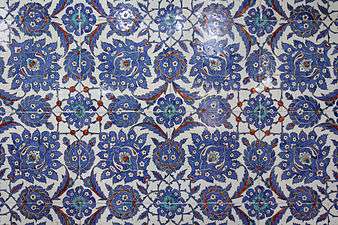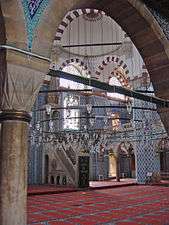Rüstem Pasha Mosque
| Rüstem Pasha Mosque | |
|---|---|
|
Rüstem Pasha Mosque (in foreground) | |
| Basic information | |
| Location | Istanbul, Turkey |
| Geographic coordinates | 41°01′03″N 28°58′07″E / 41.01750°N 28.96861°ECoordinates: 41°01′03″N 28°58′07″E / 41.01750°N 28.96861°E |
| Affiliation | Islam |
| Architectural description | |
| Architect(s) | Mimar Sinan |
| Architectural type | mosque |
| Groundbreaking | 1561 |
| Completed | 1563 |
| Specifications | |
| Minaret(s) | 1 |
| Materials | granite, marble |

The Rüstem Pasha Mosque (Turkish: Rüstem Paşa Camii) is a 16th-century Ottoman mosque located in Hasırcılar Çarşısı (Strawmat Weavers Market) in the Tahtakale neighborhood, of the Fatih district of Istanbul, Turkey.
History
The Rüstem Pasha Mosque was designed by Ottoman imperial architect Mimar Sinan for the grand vizier Rüstem Pasha (the husband of one of the daughters of Suleiman the Magnificent by Hürrem Sultan (Roxelana), Mihrimah Sultan). Rüstem Pasha died at age 61 in July 1561 and the mosque was built after his death from around 1561 until 1563.[1] The mosque complex hosts now a religious school.[2]
Architecture
Exterior
The mosque was built on a high terrace over a complex of vaulted shops, whose rents were intended to financially support the mosque complex. Narrow, twisting interior flights of steps in the corners give access to a spacious courtyard. The mosque has a double porch with five domed bays, from which projects a deep and low roof supported by a row of columns.[3]
Interior
The Rüstem Pasha Mosque is famous for its large quantities of İznik tiles, set in a very wide variety of floral and geometric designs, which cover not only the façade of the porch but also the mihrab, minbar and walls. There are around 80 different patterns.[4] These tiles exhibit the early use of Armenian bole, a tomato-red pigment that would become characteristic of İznik pottery. Some of the tiles, particularly those in a large panel under the portico to the left main entrance, are decorated with sage green and dark manganese purple that are characteristic of the earlier 'Damascus ware' coloring scheme.[5] No other mosque in Istanbul makes such a lavish use of these tiles.[6]
 | |
|
|
The plan of the building is basically that of an octagon inscribed in a rectangle. The main dome rests on four semi-domes; not on the axes but in the diagonals of the building. The arches of the dome spring from four octagonal pillars— two on the north, two on the south— and from piers projecting from the east and west walls. To the north and south are galleries supported by pillars and by small marble columns between them.[3]
Gallery
 Portico
Portico Iznik tiles at entrance
Iznik tiles at entrance Iznik tiles
Iznik tiles Interior view
Interior view Interior view
Interior view Mihrab
Mihrab
See also
- Islamic architecture
- List of mosques
- Ottoman architecture
- Mosques commissioned by the Ottoman dynasty
References
- ↑ Necipoğlu 2005, pp. 321-322.
- ↑ Rüstem Pasha Mosque
- 1 2 Freely, Blue Guide Istanbul
- ↑ Denny 2004, pp. 79-94.
- ↑ Carswell 2006, pp. 74–76.
- ↑ Denny 2004.
- ↑ "Mimar Sinan, Rüstem Pasha Mosque, Istanbul, 1561-63". Smarthistory at Khan Academy. Retrieved January 10, 2014.
Sources
- Carswell, John (2006) [1998], Iznik Pottery, London: British Museum Press, ISBN 978-0-7141-2441-4
- Denny, Walter B. (2004), Iznik: The Artistry of Ottoman Ceramics, London: Thames & Hudson, ISBN 978-0-500-51192-3.
- Faroqhi, Suraiyah (2005). Subjects of the Sultan: Culture and Daily Life in the Ottoman Empire. I B Tauris. ISBN 1-85043-760-2.
- Freely, John (2000). Blue Guide Istanbul. W. W. Norton & Company. ISBN 0-393-32014-6.
- Necipoğlu, Gülru (2005), The Age of Sinan: Architectural Culture in the Ottoman Empire, London: Reaktion Books, ISBN 978-1-86189-253-9.
- Rogers, J.M. (2007). Sinan: Makers of Islamic Civilization. I B Tauris. ISBN 1-84511-096-X.
Further reading
- Denny, Walter B. (1977). The ceramics of the Mosque of Rüstem Pasha and the environment of change. New York: Garland. ISBN 0-8240-2684-5.
- Schick, Leslie Meral (1990). "A note on the dating of the Mosque of Rüstem Paṣa in İstanbul". Artibus Asiae. 50 (3/4): 285–288. JSTOR 3250073..
External links
| Wikimedia Commons has media related to Rüstem Pasha Mosque. |
- "Rüstem Pasa Mosque". ArchNet.
- Photographs by Dick Osseman, PBase
- 360 degree panoramic view of the mosque interior, 3dmekanlar.

